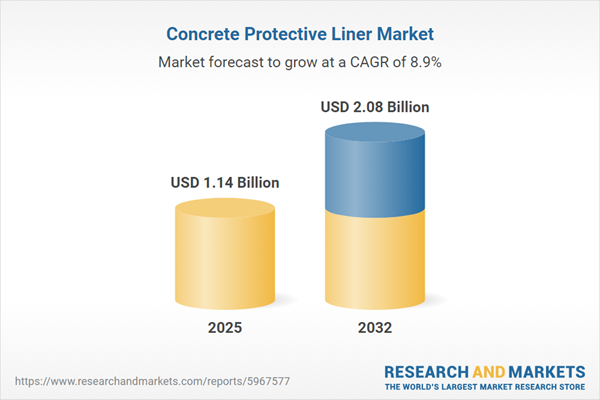Speak directly to the analyst to clarify any post sales queries you may have.
Amid ongoing infrastructure expansion and increasingly stringent regulations worldwide, the concrete protective liner market is evolving rapidly. Advanced liners are becoming a cornerstone for safeguarding concrete across diverse industrial environments, delivering critical protection and supporting long-term asset performance.
Market Snapshot: Concrete Protective Liner Market Growth Overview
The concrete protective liner market grew from USD 1.05 billion in 2024 to USD 1.14 billion in 2025, with projections indicating sustained expansion at a CAGR of 8.94%, reaching USD 2.08 billion by 2032. Market momentum is driven by regulatory compliance, urban construction, and rising demand for durability in public and private infrastructure. This surge highlights the sector’s increasing adoption as a standard practice in construction, energy, and water management.
Scope and Segmentation of the Concrete Protective Liner Market
This comprehensive research explores the following market segmentation, delivering detailed intelligence at each level:
- Application Areas: Abrasion protection coverings for flooring and pipelines; corrosion defense for pipelines, tanks, and vessels; waterproofing for basements, decks, concrete and metal roofs.
- End Uses: Commercial spaces such as office buildings and retail locations; industrial settings including oil & gas and wastewater treatment; residential construction for foundational and roofing needs.
- Material Types: Polyethylene for abrasion defense; polyvinyl chloride for chemical resistance and flexibility; rubber for environments requiring high flexibility and crack-bridging performance.
- Installation Methods: New installations; replacement of existing liners.
- Thickness Variations: 1–2 mm, 2–5 mm, and above 5 mm to meet specific performance needs and installation protocols.
- Regions:
- Americas: North America (United States, Canada, Mexico) and Latin America (Brazil, Argentina, Chile, Colombia, Peru)
- Europe, Middle East & Africa: Europe (United Kingdom, Germany, France, Russia, Italy, Spain, Netherlands, Sweden, Poland, Switzerland), Middle East (United Arab Emirates, Saudi Arabia, Qatar, Turkey, Israel), Africa (South Africa, Nigeria, Egypt, Kenya)
- Asia-Pacific: China, India, Japan, Australia, South Korea, Indonesia, Thailand, Malaysia, Singapore, Taiwan
- Key Companies: Sika AG, BASF SE, MAPEI S.p.A., RPM International Inc., The Sherwin-Williams Company, Hempel A/S, GCP Applied Technologies Inc., Fosroc International Ltd., Akzo Nobel N.V., PPG Industries, Inc.
Key Takeaways for Decision-Makers
- Growth is largely propelled by advanced polymer and rubber-based technologies that withstand abrasion, corrosion, and moisture challenges in critical infrastructure.
- Regulatory trends are fostering low-VOC and recyclable liners, prompting significant innovation in material science.
- Digital monitoring tools are transforming liners from static barriers into data-enabled, proactive asset management solutions with predictive maintenance potential.
- Leading manufacturers distinguish themselves through strategic R&D partnerships, bundled technical services, and rapid adaptation to diverse regulatory requirements.
- Regional nuances shape demand: for example, the Americas prioritize operational uptime, EMEA emphasizes sustainability, and Asia-Pacific focuses on scalable waterproofing for new assets.
- Investment in customer-centric service models and flexible production capabilities is now essential for maintaining competitive advantage in the maturing protective liner sector.
Tariff Impact on Supply Chains and Procurement
Recent United States tariff adjustments are reshaping supply chain strategies and driving a shift toward domestic sourcing of polymers and rubber derivatives. Manufacturers are strengthening local partnerships to mitigate import-related cost pressures, and many customers are locking in pricing through strategic agreements, fostering more resilient procurement cycles and reinforcing the need for transparent vendor relationships.
Methodology & Data Sources for Market Research
This report utilizes a multi-method research framework that includes comprehensive secondary analysis of industry studies, market publications, and patent databases. Primary research involves structured interviews with industry experts and supply chain stakeholders. Rigorous data triangulation and validation protocols, including expert panel reviews, ensure the reliability and accuracy of findings throughout the research process.
Why This Report Matters for Senior Decision-Makers
- Gain actionable insight into technology trends, end-user demands, and regional growth opportunities within the concrete protective liner industry.
- Stay ahead of evolving environmental regulations and supply chain risks impacting procurement and investment decisions.
- Benchmark competitive strategies of major players and anticipate shifts driven by digital transformation and sustainability priorities.
Conclusion
The evolving concrete protective liner market requires an informed, multi-faceted strategy for sustainable growth. This report delivers the intelligence needed to anticipate change, support innovation, and drive confident investment decisions in an increasingly dynamic environment.
Additional Product Information:
- Purchase of this report includes 1 year online access with quarterly updates.
- This report can be updated on request. Please contact our Customer Experience team using the Ask a Question widget on our website.
Table of Contents
3. Executive Summary
4. Market Overview
7. Cumulative Impact of Artificial Intelligence 2025
Companies Mentioned
The companies profiled in this Concrete Protective Liner market report include:- Sika AG
- BASF SE
- MAPEI S.p.A.
- RPM International Inc.
- The Sherwin-Williams Company
- Hempel A/S
- GCP Applied Technologies Inc.
- Fosroc International Ltd.
- Akzo Nobel N.V.
- PPG Industries, Inc.
Table Information
| Report Attribute | Details |
|---|---|
| No. of Pages | 193 |
| Published | October 2025 |
| Forecast Period | 2025 - 2032 |
| Estimated Market Value ( USD | $ 1.14 Billion |
| Forecasted Market Value ( USD | $ 2.08 Billion |
| Compound Annual Growth Rate | 8.9% |
| Regions Covered | Global |
| No. of Companies Mentioned | 11 |









